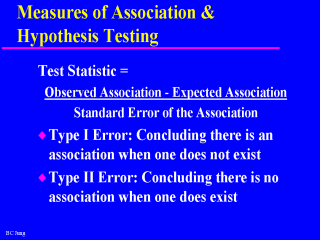| front |1 |2 |3 |4 |5 |6 |7 |8 |9 |10 |11 |12 |13 |14 |15 |16 |17 |18 |19 |20 |21 |22 |23 |24 |25 |26 |27 |28 |29 |30 |review |
 |
Hypotheses
address questions about whether an observed difference in health status, risk and
protective factors, health services or health systems indicators are real or spurious.
Hypotheses of mean, proportion or rate can be tested by comparing them to a standard. Observed association - the comparison of a single estimate and a standard, or the comparison of two or more estimates. Expected association - same comparison but under what is called the null hypothesis, or the assumption that no association exists. Observed associations and the test statistics used for evaluating them follow known probability distribution. Critical values can be chosen to assess the probability that the observed associations is different from their expected values. The probability of interpreting an observed association as real when it is in fact due to chance, or the probability of committing a Type I error, is what is reported as the p-value. By convention, associations are considered statistically significant when the p-value is <0.05. Any result from a statistical test based on the standard normal curve which is <-1.96 or >1.96 means there is less than 5% probability (<0.05) that observed differences are due to chance alone. (Or, itís probably due to something other than chance, like your intervention, or, the factor under observation). |